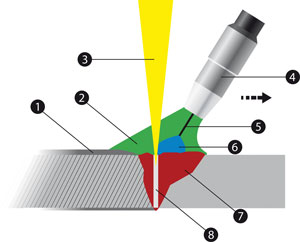
A numerical finite element model was developed to simulate the hybrid laser arc welding of different aluminum alloys, namely 5XXX to 6XXX series. The study was conducted mainly by the Research Center for Advanced Manufacturing and Technology (RCAM) of Southern Methodist University, Dallas, USA. The numerical simulation has been considered two double-ellipsoidal heat sources for the gas metal arc welding and laser welding. The offset distance of the metal arc welding and laser showed a significant effect on the molten pool geometry, the heat distribution and penetration depth during the welding process. It was confirmed that when the offset distance is within the critical distance the laser and arc share the molten pool and specific amount of penetration and dilution can be achieved. The models and experiments show that the off-distance between the two heat sources and shoulder width have considerable influence on the penetration depth and appearance of the weld beads. The experiments also indicate that the laser power, arc voltage and type of the filler metal can effectively determine the final properties of the bonds, specifically the bead appearance and microhardness of the joints. The experiments verified the numerical simulation as the thermocouples assist to comprehend the amount of heat distribution on the T-joint coupons. The role of the welding parameters on the mechanism of the hybrid laser welding of the aluminum alloys was also discussed.



